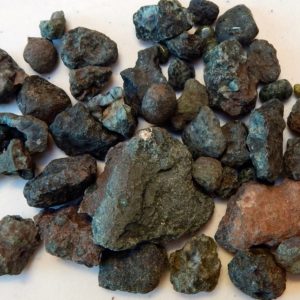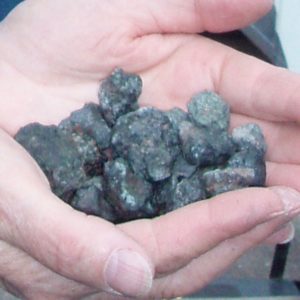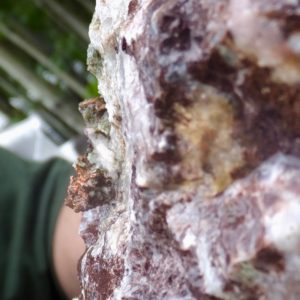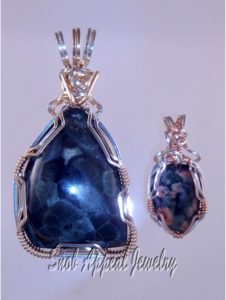
GREENSTONES GALORE
Thirty years ago things were different in the Keweenaw. Rock hunting sights were plentiful, and hunting was good. Today rock hunting areas are scarce, as mine spoil piles are bought up to be crushed and sold for road fill. Often logging companies purchase the piles to crush and use for logging roads. It seems to me that the Keweenaw has been pilfered of all its soil-based resources, and what is especially disturbing is that the whole area is a national historic park.

I’m setting on the base of what once was a pile of rubble far higher then full grown trees.
Much of the history of the Copper Country revolves around the mining of copper. With the disappearance of the mine waste piles, the history of the area is that much harder to experience and visualize. Most of what is left is privately owned and off limits to rock hounds, except a few times a year when sponsored events are arranged where mine owners are reimbursed for rock hounds hunting their piles.
We travel the Keweenaw every August for art shows at Eagle Harbor and Copper Harbor and our retail outlet Copper World in Calumet. (Lake Superior Magazine listed Copper World at the top Michigan gift shop for the sixth year in a row! (It is great to be represented at such a fine store).

At the campground, sorting what to take and what to leave. We really could not tell until we washed the mud off them.

Took these home. I will either cut them out or hammer them out.

What Greenstone look like after being extracting from the mine rock.

Often Greenstone have fallen out of the rocks and can be found just laying on the ground or in the piles.
If you want to hunt Greenstones or other copper-related minerals currently two organized rock hunt opportunities are available, arranged by the Seaman Mineral Museum, and by the Copper Country Rock Club. The groups arrange to have the mine waste piles bulldozed and participants who have paid the fee get to have first look at trying to find a new treasure that has been buried for decades (or eons) and brought to the surface by the bulldozer.  We have participated in many of these hunts over the years. Sometimes they are worthwhile and sometimes they are a disappointment.


Clearly there is Copper in this one.
Rain is the rock hounds friend, rinsing the dirt off the rock that was stirred up in the recent few weeks of organized hunts. This year we were able to go hunting between art shows on a couple of rainy days. We were successful in finding greenstones, datolite, prehnite, and native copper. Often we pick up muddy things that look of interest, and after cleaning may turn out to be wonderful finds. And sometimes a promising rock is disappointing. You often don’t know what you have until you do the lapidary work.

Dopping begins the grinding and polishing process. I use, nails, screws, rivets and glue the stones on to the Dops. Others use dopping wax.
Keweenaw Greenstones are especially tricky, they may have no pattern, or they may break apart. What appears to be a fine Greenstone, as you work it, may in fact be hollow; you have something, than you have nothing. Working Michigan State Gem Greenstones to their maximum potential takes a gentle hand, and lots of patience. When polishing a large stone I get excited if it has a great alligator pattern and a chatoyant surface. The other thing about greenstones is that it dictates how it can be cut. Sometimes the pattern layer is so thin, that you have to know when to stop grinding. You may or may not be able to eliminate inclusions that distract from a perfect stone.  Those I give to teachers that teach Earth Sciences. Only experience tells you if you have the stone perfect, or if you can make it better. They are a uniquely difficult gemstone to get right, and in general the highest quality Greenstones can be pricey. Many greenstones must be cut before I get a one that has the qualities expected in a gem. If you have a large stone you want to have polished, be sure to have someone cut it that has experienced in cutting Greenstones. I’ve seen $1000 Greenstones ruined because the person cutting it did not know what they were doing. I liken some Greenstones to Fire Agate; You have to know when to stop, and there is no room for error.
Another truth is that Most Michiganders have never personally seen an Isle Royale Greenstone, and I have been asked things like “is that a Green Petoskey Stone?” or they’ll say things like “I found one of them on Lake Michigan” NOT! One of these , usually small stoned, would never survive the glacial transportation. A picture does not do justice to the lovely, silky, Chatoyancy or Michigan’s State Gemstone. You have to see one in person to appreciate it. They’re like an alligator wearing a shear silky robe.

This is a “Broll”. It’s made my life easier. Do a search if you are interested; it’ll save me answering a bunch of questions. This picture was takenon a Petoskey Stone Hunt.
Bonnie always takes home a couple garden rocks, and our Broll is a handy tool for carrying rocks back to the car. For those who haven’t seen one, you can see and buy a Broll online; we take it on all our rock hunts.

A beautiful Thomsonite flowered Greenstone from the Phoenix Mine.
People look for us at the art shows and bring something that they have found to have a special piece of jewelry made for them. Cutting their rocks and making their jewelry keeps me busy for a while.
Even though gemstone hunting is not what it once was, we still enjoy our trips. The art shows, natural beauty, wonderful sunsets, rock hunts, pasties, Vollwerth’s hot dogs, and monk’s muffins all contribute to a vacation atmosphere while we are doing our work!





























